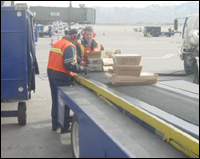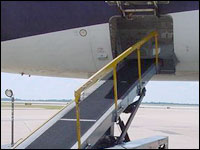The wide body aircraft may have either an automated
or semi-automated loading system. Potential hazards involve transferring
baggage from baggage carts to the airplane, stacking the bags in the
cargo bin, and transferring the baggage from the airplane back to
the carts. The most common hazards are found in the following areas:
For additional hazards, see these sections in
the manual loading
module:
| Beltloaders |
 |
|
 Figure 1.
Vertical position of beltloader when unloading the carts
Figure 1.
Vertical position of beltloader when unloading the carts
 Figure 2.
Vertical position of beltloader when loading the carts
(between waist and chest height)
Figure 2.
Vertical position of beltloader when loading the carts
(between waist and chest height)
- Positioning the bottom (end closest to the cart)
of the beltloader too low may cause agents to bend
at the waist when placing or removing baggage. This
can lead to unnecessary stresses on the body.
- Positioning the bottom of the beltloader too high
may cause agents to raise their shoulders or extend
their elbows away from their body when placing or
removing baggage.
Possible Solutions
- Adjust the height of the bottom of the beltloader
to assure optimum lifting heights based on loading
conditions and the type of cart used. Place belt at
a height that will ensure good posture while lifting
baggage to and from the belt and baggage cart.
- When unloading the cart, the vertical
position of the beltloader should
be level with or just below the cart
bottom. (Figure 1)
- When taking bags from the beltloader
to the cart, raise the belt to at
least waist height. This reduces bending
and facilitates loading by working
with gravity (moving from a higher
location to a lower location). (Figure
2)
 Figure 3.
Vertical position of beltloader when loading the cargo
bin
Figure 3.
Vertical position of beltloader when loading the cargo
bin
 Figure 4.
Vertical position of beltloader when unloading the cargo
bin.
Figure 4.
Vertical position of beltloader when unloading the cargo
bin.
 Figure 5.
Secure the railing
Figure 5.
Secure the railing
Potential
Hazards
- Positioning the top of the beltloader too low forces
agents to bend and lift bags up to put them into the
cargo bin.
- Positioning the top of the beltloader too far away
from the cargo bin may require agents to reach to
pull bags into the compartment.
Possible
Solutions
- Position beltloader at the edge of the
cargo compartment opening to minimize
gaps so agents do not have to reach to
access items.
- Elevate and place beltloader inside
the cargo bin when loading so items are
deposited close to the agent. This minimizes
reaching, pulling, and pushing. (Figure
3)
- Place beltloader at or below the lip
of the cargo bin when unloading so items
can be placed on the beltloader using
pushing and sliding motions rather than
lifting. (Figure 4)
- Secure the railing on the beltloader
before entering and exiting the cargo
bin. (Figure 5)
|
|
| Cargo Bin |
 |
|
 Figure 6.
Large or heavy baggage
Figure 6.
Large or heavy baggage
 Figure 7.
When pulling or
pushing bags, use this kneeling position.
Figure 7.
When pulling or
pushing bags, use this kneeling position.
- Handling heavy, awkward, and large bags
in a limited space places the agent in
stressful positions that can result in
injury. (Figure 6)
- Frequent lifting may lead to insufficient recovery
time and muscle fatigue.
- Performing extended reaches while working in limited
spaces can stress the neck and shoulders.
Possible
Solutions
- Educate ramp agents about proper lifting
techniques to increase awareness of good
work practices.
- Alert loading and unloading crews when
heavy bags are coming.
- Slide baggage close to the body by
pulling the handles.
- Minimize twisting by kneeling at
an angle to the belt in the direction
of loading.
- Kneel on both knees when pushing
bags or balance on one knee and one
foot. (Figure 7)
- Stack large or heavy bags on the bottom.
- Allow mechanical assist devices, such
as a sliding carpet, to bring baggage
close to you.
 Figure 8.
Kneeling in cargo bin
Figure 8.
Kneeling in cargo bin
 Figure 9.
Use kneepads when working inside the cargo bin.
Figure 9.
Use kneepads when working inside the cargo bin.
Potential
Hazards
- Kneeling in the cargo bin can
strain the knees, especially when handling
heavy baggage. (Figure 8)
- Jumping out of bins or off of equipment causes
trauma to joints.
Possible Solutions
- Use kneepads to reduce contact trauma
and abrasive injuries when kneeling on
hard surfaces. (Figure 9)
- Walk down beltloader to exit the cargo
bin.
- Educate ramp agents about proper lifting
techniques to increase awareness of good
work practices.
|
|
| Loading Bridge |
 |
|
 Figure 10.
Loading bridge
Figure 10.
Loading bridge
Potential Hazards
- Taking gate-checked baggage by hand from gate to
cargo bin places stress on the worker's shoulders
and back, especially if the bags are large or heavy.
- Taking strollers, wheelchairs, or other oddly shaped
and heavy items up or down loading bridge stairs can
be dangerous, especially during wet or icy conditions.
Possible
Solutions
- Use a hand truck or small manual cart to move individual
items of baggage over long distances.
- Use chutes, slides, or mechanical lifting devices.
|
|
|